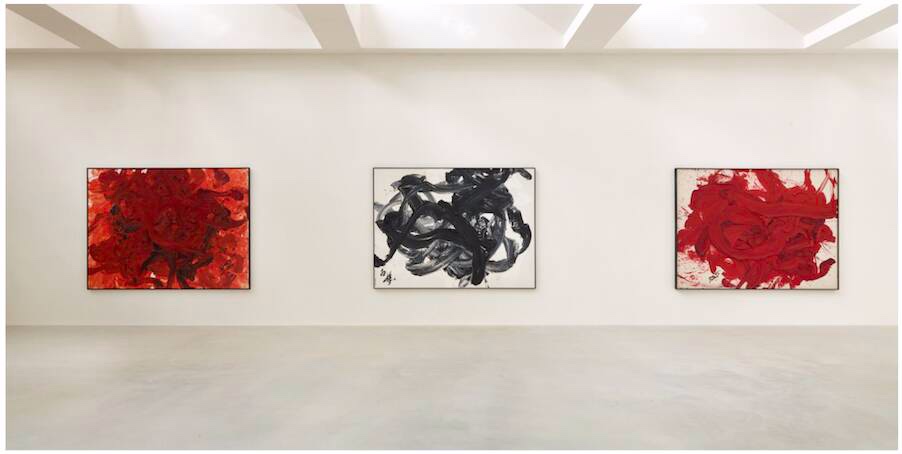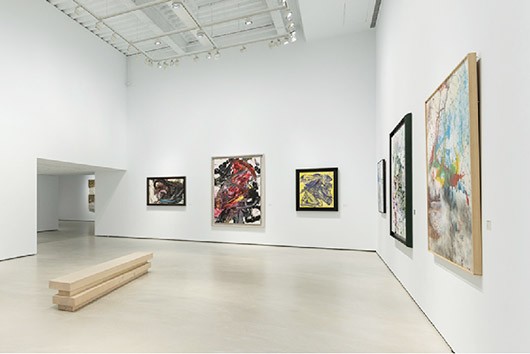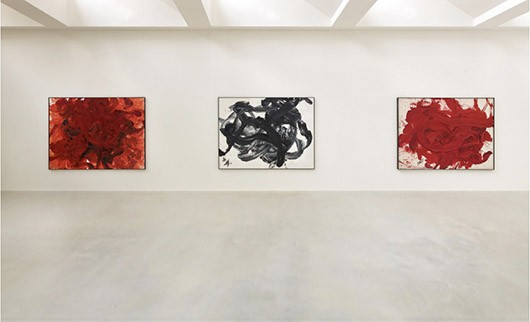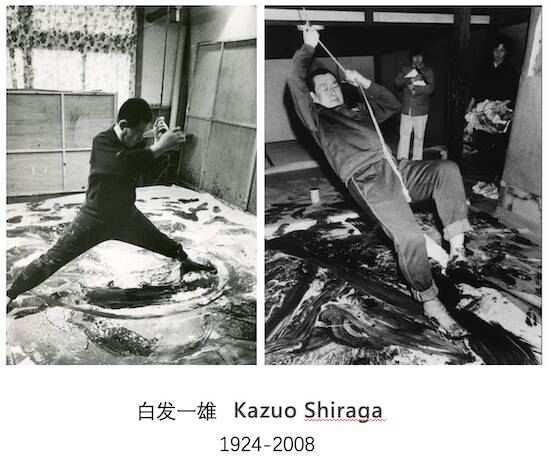
“I DECIDED TO LET GO OF ALL EXISTING RULES AND MOVE BOLDLY FORWARD. ONE DAY, I REPLACED MY PAINTING KNIFE WITH A WOODEN STICK BEFORE DISCARDING IT IMPATIENTLY. I BEGAN TO PAINT WITH MY PALMS AND FINGERS. THEN, I FELT THAT I NEEDED TO BE MORE FEARLESS. THAT WAS WHEN I STARTED USING MY FEET. THAT WAS HOW I BEGAN PAINTING WITH MY FEET!” - KAZUO SHIRAGA After World War II, existing traditional values were being challenged. As an existential mood spread across society, realism was being regarded as an outdated expression. The Western art industry strongly desired to re-examine the relevance between intrinsic spiritual values and creations via breakthrough in materials, media, and creative methods. Abstract art was on a verge of transformation during the 1950s, when American abstract expressionists Jackson Pollock, Willem de Kooning, French Lyrical Abstraction artists Georges Mathieu, Zao Wou-ki, and ideological trends, such as Op art and Minimalism, introduced different views and opinions. Amidst this wave in 1954, the Japanese Gutai was established in Asia by its founder Jiro Yoshihara as a large, formal, and organized group for abstract art. The Gutai holds important historical significance in the development and integration of Eastern and Western contemporary art. Kazuo Shiraga (1924-2008) was an important and representative member in the Gutai group. He is famous for “foot painting;” the aesthetics of this abstract performance is full of Shiraga’s personal style and power. Not only is it favored by collectors around the world, but also an indispensable element in supporting contemporary artistic contexts. Kazuo Shiraga’s works are collected by world-class museums including the National Museum of Modern Art Tokyo in Japan, the Centre Georges Pompidou in France, and the Walker Art Center in the USA. A large-scale Gutai exhibition was held at New York’s Solomon R. Guggenheim Museum in 2013. The exhibition was named Gutai: Splendid Playground, in reference to Kazuo Shiraga’s speech that year. This exhibition served as a leading example for other major museums and international galleries to organize similar series of exhibitions, thereby bringing Gutai art back to the world’s attention and academic discussion.
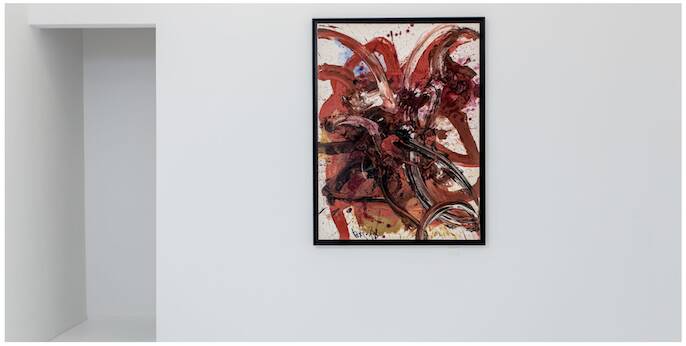
AUG 280-NOV 15,2014 AXEL VERVOORDT GALLERY, HONG KONG CHINA
As a core member of the Gutai group, Kazuo Shiraga’s works have high rankings and perform exceptionally well in the market. The popularity of Kazuo Shiraga’s works among collectors around the world established his position as a great master in the public’s mind. The pioneering work of Kazuo Shiraga’s foot painting began in mid-1950s. He poured paint onto a flat sheet of canvas and used one foot to spread paint while using the other foot to stay balanced. As to not be constrained by the limits of human balance, he later developed a unique method of painting-holding a suspension rope with both hands for balance while sliding both feet across a canvas full of paint. Through the interaction between the sensitive perception of his skin and the smooth motions of his feet, Shiraga converted abstract concepts inside his mind into colorful paintings. In addition to fulfilling Gutai art’s core philosophy of “doing things that no one has done before,” Shiraga’s method also elevated materials to a higher spiritual realm between an artist’s conscious and unconscious behaviors. The use of strong, high chroma red is also a part of Kazuo Shiraga’s famous, trademark technique. This feature makes Shiraga’s work even more unique and attractive among the majority of contemporary artworks based on Western ideologies. Through the artist’s movement, the different colors of paint display the pattern of a revolving galaxy, spreading inward from the artist’s position as center. The potential rhythm in this pattern gradually forms vivid looking lines and structures. According to literature, Shiraga’s creative inspirations came from many elements, including nature, religion, dreams, and daily experiences. He internalized these feelings and applied them onto the canvas through his “subconscious” and “body” during the creative process. His abstract style and method confirm its connections to “Art Informel” at that time. Shiraga’s use of foot painting is an “automatic technique” that subverted previous artistic techniques and reduced an artist’s level of uncertainty during the artmaking process.
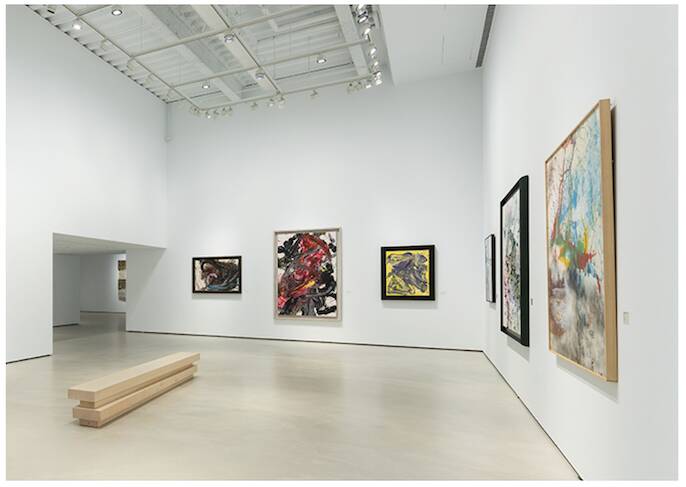
APR 13-MAY 12 GUTAI-JIN WHITESTONE GALLERY ,TAIBEI CHINA
Furthermore, this technique is also perceived as a benchmark intersection between Eastern and Western cultures in post-war contemporary art. From the materials perspective, Kazuo Shiraga chose to accept Western concepts at that time to explore the possibilities of new media. The intrinsic spirit of the painting is based on the Eastern philosophy of enhancing relationships between people, objects, and nature. In Japan, calligraphy is also known as “Shodo,” “Jubokudo” and “Hitsudo” since Buddhist texts entered Japan as a way of cultivating the mind. In 1973, Kazuo Shiraga became a Buddhist monk at Enryakuji on Mount Hiei, under his monk’s name “Sodo Shiraga.” Hence his paintings are characterized by Eastern calligraphy written in a unique flow and beautiful rhythm. This is one of the reasons why Kazuo Shiraga’s works are so intriguing. After the war, the Japanese society was in desperate need for reconstruction. When Shiraga graduated from Kyoto Municipal School of Painting, he quickly realized that traditional forms of Japanese-style painting could not serve as a new source of energy for contemporary art. Alternatively, the vivid colors and rich texture of Western oil paintings perfectly matched his personal requirement for colors, emotions, dynamic image display, and feelings about a new era of development. Shiraga founded the avant-garde art group “Zero society; Zero-kai” along with Saburo Murakami and Akira Kanayama. This group was merged into the Gutai group as per Jiro Yoshihara’s invitation. Shiraga once described his way of painting as running in a trench until the last breath. In the mid-twentieth century, Shiraga created the artistic performance, Mud Challenging, whereby the audience watched him struggle violently against the mud and the force of physics while his whole body was covered inside. At another artistic performance, Shiraga wore a red costume with very long sleeves. Wearing a spiky cone hat and mask, he continuously spun over a piece of painting paper with his bare feet. Most importantly, this method of foot painting highlighted the two earlier projects mentioned above. In this way, the element of “movement” seemingly foretold the Shiraga’s art career and how it would stun the entire world.
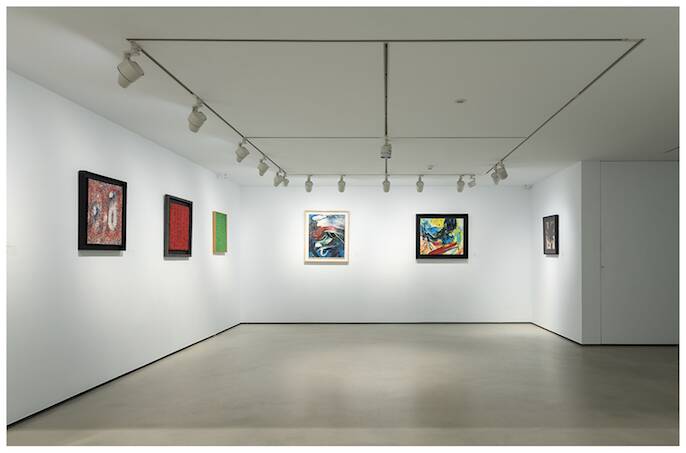
APR 13-MAY 12 GUTAI-JIN WHITESTONE GALLERY ,TAIBEI CHINA
Collection: The National Museum of Modern Art (Tokyo), The Ashiya City Museum of Art & History (Hyogo, Japan), Pompidou Centre (Paris), Walker Art Center (Minneapolis, USA), Museé Cantini (Marseille, France), etc.

